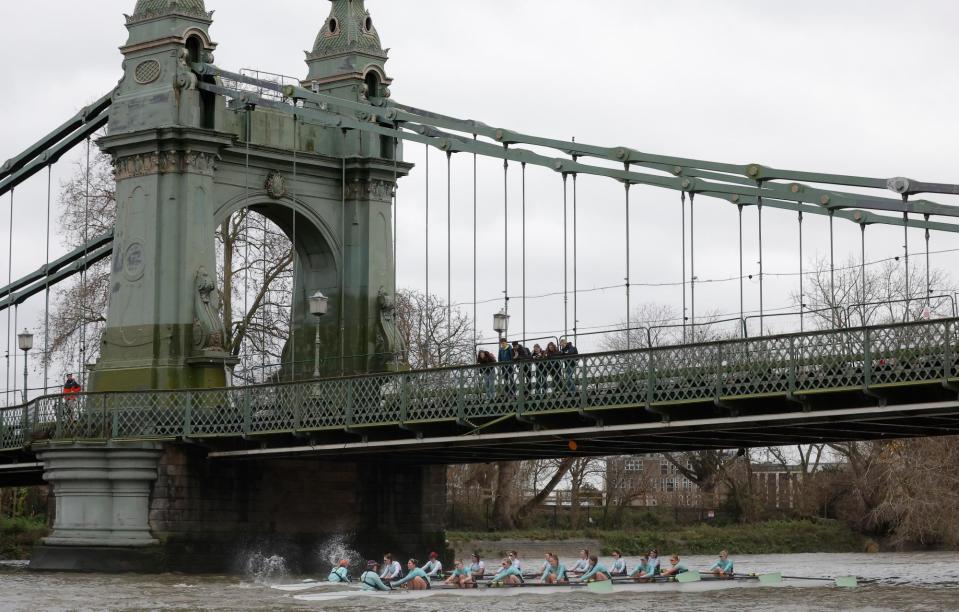Do not enter the water: how dirty Boat Race has captured world’s attention

Throughout the Boat Race’s 195-year history, it has been regarded by the rest of the world as one of those peculiar British eccentricities, like Marmite and pantomime, that are best ignored. Not this year.
The New York Times, Fox News, ABC, CNN and numerous other international media have run stories in the buildup to Saturday’s race – although it is what is floating in the Thames, rather than on top of it, that has piqued their interest.
As Thursday’s New York Times put it: “The warning was stern: Do not enter the water. Not because of the tide. Not because of sharks. Because of the sewage.
Related: Pulling together: how Cambridge came to dominate the Boat Race – photo essay
“For almost two centuries, rowers from Oxford University have raced their rivals from Cambridge in a contest that typically ends with jubilant members of the victorious crew jumping into the River Thames in celebration. This year they will be staying as dry as possible.”
The discovery of high levels of E coli on the 4.25-mile course has not only further fuelled public anger at the deteriorating state of Britain’s rivers, but – as first revealed by the Guardian – also led organisers to issue tough new safety guidelines.
And according to Cambridge’s Carys Earl, a 21-year-old medicine undergraduate, everyone is taking those rules very seriously. “As soon as we get off the water – and before we touch any of our other kit or food – we immediately wash our hands,” she says. “We are also showering, covering cuts or bruises, and then making sure we’ve got fresh kit to get into. We’re constantly washing the boats and washing equipment as well.”
Meanwhile Oxford’s Annie Sharp, a 24-year-old who is studying for an MSc in water science, policy and management, has a professional as well as sporting interest in the gunk in the Thames. “The problem links back to the Victorian era,” she points out. “The sewage system was fantastic at the time, but it was built for a two million population. Now we have over 9.5 million.
“But there’s a really strong focus on innovation to make things better,” she says, pointing to new biofilter technology and different ideas to prevent nitrates leaching into the groundwater. “While for the River Thames, there is the Super Sewer, which will be finished this year. I was part of working on that previously, and I think it’s going to be really fantastic and transformative.”
But Earl’s and Sharp’s focus is mostly on Saturday afternoon when more than 250,000 people are expected to crowd the Thames for the 78th women’s and 169th men’s Boat Race. For Earl it has been some journey, given that she went to state school and stepped into a boat only when she arrived at Cambridge.
“My college put on a barbecue in Freshers’ Week and said anyone who’s interested can come down and get in the boat,” she says. “I thought it would be a bit of fun, and so I signed up for the novice programme. I absolutely loved it and it just sort of continued.”
Such has been Earl’s progress that she is now trying out for the British Under-23 squad. “It’s everybody’s dream to compete for a national team,” she says. “We’ve done erg tests, and my partner and I also went to the GB water trials where we came third overall, and first for the Under 23s, so we’ve now been invited back to the second round later in April. But for now all my focus is on Saturday’s race.”
Earl will be sitting in the six seat, part of the engine room of Cambridge’s boat. But when she glances across at the start she will see Sharp, sitting in the same position for Oxford, confident of victory.
“We’ve got a lot of fantastic talent in our boat,” says Sharp, who is determined to win so she can tease her father, who rowed in the Isis (reserve) boat in 1990 but was disqualified at the bandstand. “We have six fantastic returnees. So people aren’t gonna be fazed by anything that happens in the race. Since day one we’ve really been building a fantastic boat and boat speed.”
The bookies agree with that assessment. Cambridge have won six straight in the women’s race, as well as four of the past five men’s races. However, Oxford are favourites this year in both events. But one randomising factor, according to Sharp, is the high water levels of the Thames this week, which have made conditions “definitely bumpy”.
Whatever happens, Earl says that the fact both Oxford and Cambridge have fused their men’s and women’s teams into one club over the past two years is further proof of the progress the women are making.
“There’s a lot better inclusivity and equality,” she says. “Getting to race on the Tideway on the same day as the men, as we have done since 2015, has been a gamechanger.”

